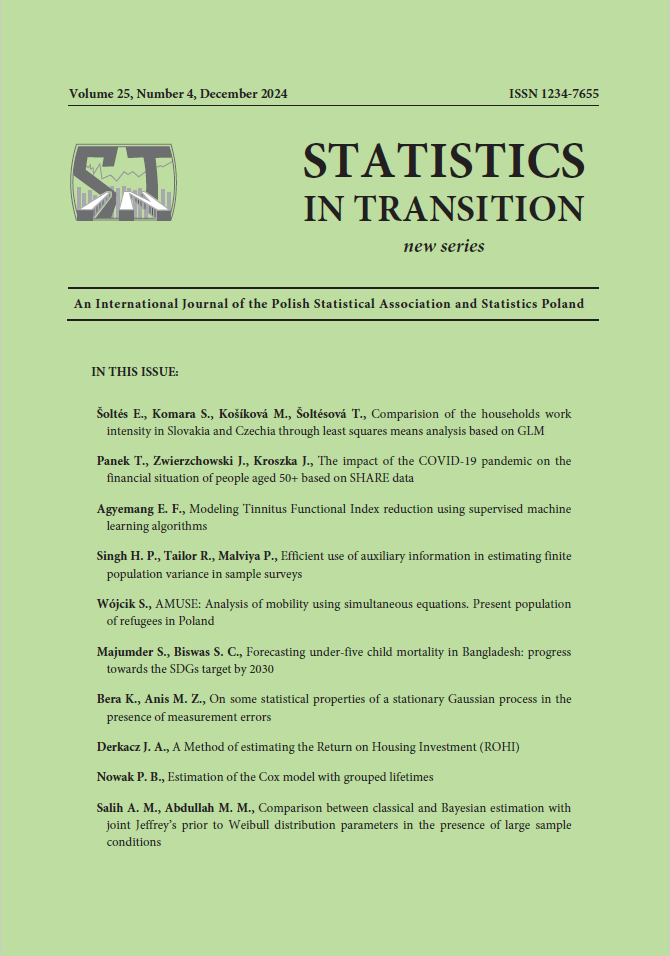ARTICLE
ABSTRACT
In order to facilitate progress towards achieving the SDGs target regarding under-five child mortality in Bangladesh, the study explores the relevant mortality trends and makes a projection of the situation by 2030. The yearly dataset regarding mortality among children aged five and under (per 1,000 live births) in Bangladesh employed in this study was collected from the World Bank Databank (https://data.worldbank.org/indicator) for the 1972-2022 period. The selection of the best-fitted model for the purpose of forecasting was between the ARIMA model and the Double Exponential Smoothing Holt’s Method. Compared with the ARIMA (1,2,1) model, the Double Exponential Smoothing Holt’s method proved the best-fitted model for forecasting the under-five child mortality in the future. The results show that under-five child mortality in Bangladesh is an annually declining trend. The average under-five child mortality is forecasted to drop by one during the 2023-2035 period. Thus, the predicted value of under-five child mortality would be 26 in 2025 and 22 in 2030, which contributes to the achievement of the national target of 27 (per 1,000 live births) in 2025 and the SDGs target (25 deaths per 1,000 live births) regarding the under-five mortality rate. Bangladesh will then achieve the SDGs target regarding the under-five child mortality by 2026 if the existing strategy and plan of reducing under-five child mortality is successful.
KEYWORDS
under-five child mortality, forecasting, SDGs, Bangladesh.
REFERENCES
Ahmed, T., Mahfuz, M., Ireen, S., Ahmed, A. S., Rahman, S., Islam, M. M., et al., (2012). Nutrition of children and women in Bangladesh: trends and directions for the future. Journal of Health, Population, and Nutrition, Vol. 30, No. 1, pp. 1-11.
BDHS, (2014). Bangladesh Demographic and Health Survey (BDHS), 2014. NIPORT, Dhaka, Bangladesh; Mitra and Associates, Dhaka/ Bangladesh.
Box, G. E. P., Jenkins, G. M., (1976). Time series analysis, forecasting and control. Holden Day: San Francisco, California, USA, p. 625.
Box, G. E. P., Pierce, D., (1970). Distribution of Residual Autocorrelations in Auto-regressive Integrated Moving Average Time Series Models. Journal of the American Statistical Association, Vol. 65, pp. 1509–1526.
Chao, F., et al., (2018). National and regional under-5 mortality rate by economic status for low-income and middle income countries: a systematic assessment. The Lancet Global Health, Vol. 6, No. 5, pp. 535–547. https://doi.org/10.1016/S2214-109X(18)30059-7.
Chen, H. U., Guoa, S., Chong-Yu X. U., Singh, V. P., (2007). Historical temporal trends of hydro-climatic variables and runoff response to climate variability and their relevance in water resource management in the Hanjiang basin. Jour. Hydrol., Vol. 344, pp. 171–184.
GoB, (2020a). Sustainable Development Goals: Bangladesh Progress Report 2020, SDGs Publication No. # 23 by Bangladesh Planning Commission, Ministry of Planning, Government of the People’s Republic of Bangladesh (GoB), Dhaka.
GoB, (2020b). 8th Five Year Plan (July 2020-June 2025), General Economics Division (GED), Bangladesh Planning Commission, Government of the People’s Republic of Bangladesh (GoB), Dhaka.
Hesel, D. R., Hirsch, R. M., (1992). Statistical Methods in Water Resources, Elsevier, Amsterdam.
Holt, C. E., (1957). Forecasting seasonals and trends by exponentially weighted averages (O.N.R. Memorandum No. 52). Carnegie Institute of Technology, Pittsburgh USA. https://doi.org/10.1016/j.ijforecast.2003.09.015
Hyndman, R. J., (2006). Another Look At Forecast-Accuracy Metrics For Intermittent Demand. Foresight, 4, pp. 43–46.
Khan, J. R., Awan N., (2017). A comprehensive analysis on child mortality and its determinants in Bangladesh using frailty models. Archives of Public Health, Vol. 75, No. 1, p. 58. https://doi.org/10.1186/s13690- 017-0224-6.
Kendall, M. G. (1975). Rank Correlation Methods. Charles Griffin: London.
Machiwal, D., Jha, M. K., (2008). Comparative evaluation of statistical tests for time series analysis: Application to hydrological time series. Hydrological Sciences, Journal-des Sciences Hydrologiques, Vol. 53, No. 3, pp. 353–366.
Mann, H. B., (1945). Nonparametric tests against trend. Econometrica, Vol. 13, pp. 245–259.
McGuire, J. W., (2006). Basic health care provision and under-5 mortality: a cross-national study of developing countries. World Development, Vol. 34, NO. 3, pp. 405–425.
Mega, F., (2003). Strategi Bersama Masyarakat Sipil Indonesia: Empat Pilar Demokratisasi untuk Melawan Kemiskinan dan Pemiskinan. Jakarta: Gerakan Anti Pemiskinan (GAPRI).
MICS, (2019). Progotir Pathey, Bangladesh Multiple Indicator Cluster Survey, Survey Findings Report. Dhaka, Bangladesh: Bangladesh Bureau of Statistics (BBS) and UNICEF Bangladesh.
Nino, F. S., (2015). Sustainable Development Goals. United Nations.
Nurkse, R., (1953). Problems of Capital Formation in Underdeveloped Countries.
UN, (2015). The Millennium Development Goals Report. The United Nations, New York, USA.
UNICEF, (2018). 2018–2021 Progress Report - Save Newborns, UNICEF South Asia.
UNIGME, (2020). ‘Levels & Trends in Child Mortality: Report 2020. The United Nations Inter-agency Group for Child Mortality Estimation (UNIGME), United Nations International Children's Emergency Fund, New York.
WHO, (2018). WHO | Under-five mortality, World Health Organization (WHO).
WHO, (2016). World health statistics 2016: monitoring health for the SDGs sustainable development goals, World Health Organization (WHO).
Wilson, J. H., Keating, B., (2007). Business Forecasting with Accompanying Excel-Based ForecastX Software, 5th ed., Boston, Mass: McGraw-Hill.
Zainun, N. Y., dan Majid, Z. A., (2003). Low Cost Demand Predictor, Malaysia. Universitas Teknologi Malaysia.
